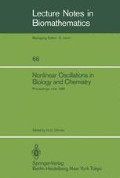Abstract
Fish of many species propel themselves through water by rhythmic undulations; fins are used for stabilization and change of direction, but not for stereotypic straight line movements [1], The undulations are caused by contractions which pass down the muscles along the spinal cord (with muscles on the opposite sides of the fish 180° out of phase). These contractions are in turn directed by motoneurons which emerge from special positions in the spinal cord having a spatial periodicity that matches the segmentation of the backbone. Measurements from these positions (“ventral roots”) show rhythmic voltage changes (bursts of activity) at each such point, with a uniform frequency and a phase lag between any two points that are proportional to the distance between the points; i.e., the neural activity is a constant speed travelling wave. For technical reasons, much of this data has been gathered for dogfish and lamprey [1,2]; some of the observations have been corroborated for other species.
Access this chapter
Tax calculation will be finalised at checkout
Purchases are for personal use only
Preview
Unable to display preview. Download preview PDF.
References
Grillner, S. and Kashin, S., “On the generation and performance of swimming in fish,” in Neural Control of Locomotion, R. M. Herman, S. Grillner, P. S. G. Stein and D. G. Stuart, eds., Plenum, NY (1976).
Grillner, S., “On the generation of locomotion in the spinal dogfish,” Exp. Brain Res. 20, 459–470 (1974).
Forssberg, H., Grillner, S., Rossignol, S. and Wallen, P., “Phasic control of reflexes during locomotion in vertebrates,” in Neural Control of Locomotion, R. M. Herman, S. Grillner, P. S. G. Stein and D. G. Stuart, eds., Plenum, NY, 647–674 (1976).
Grillner, S. and Wallen, P., “On peripheral control mechanisms acting on the central pattern generators for swimming in the dogfish,” J. Exp. Biol. 98, 1–22 (1982).
Grillner, S., “Mechanosensitive neurons in the spinal cord of the lamprey,” Brain Res. 235, 169–173 (1982).
Grillner, S., “Locomotion in vertebrates: central mechanisms and reflex interactions,” Physiol. Rev. 55, 247–304 (1975).
Eisen, J. S. and Marder, E., “A mechanism for production of phase shifts in a pattern generator,” J. Neurophys. 51, 1375–1393 (1984).
Poon, M., Friesen, W. D. and Stent, G. S., “Neural control of swimming in the medicinal leech, V., connections between the oscillatory interneurons and the motor neurons,” J. Exp. Biol. 75, 45–63 (1978).
Grillner, S., “Control of locomotion in bipeds, tetrapods and fish,” in Handbook of Physiology, Section 1: The Nervous System, 2, V. B. Brooks, ed., Amer. Physiol. Soc, Bethesda, 1179–1236 (1981).
Rinzel, J., “Models in neurobiology,” in Nonlinear Phenomena in Physics and Biology, R. H. Enns, B. L. Jones, R. M. Miura and S. S. Rangnekar, eds., Plenum, 345–367 (1981).
Kopell, N. and Howard, L. N., “Plane wave solutions to reaction-diffusion equations,” Studies in Appl. Math. 52, 291–328 (1973).
Kopell, N., “Toward a theory of modelling central pattern generators,” to appear in Neural Control of Rhythmic Movements, A. H. Cohen, S. Grillner and S. Rossignol, eds., J. Wiley, NY.
Kopell, N. and Ermentrout, G. B., “Symmetry and phase-locking in chains of weakly coupled oscillators,” to appear.
Ermentrout, G. B. and Kopell, N., “Frequency plateaus in a chain of weakly coupled oscillators, I,” SIAM J. Math. Anal. 15, 215–237 (1984).
Cohen, A. H., Holmes, P. J. and Rand, R. H., “The nature of the coupling between segmental oscillators of the lamprey spinal generator for locomotion: a mathematical model,” J. Math. Biol. 13, 345–369 (1982).
Fenichel, N., “Persistence and smoothness of invariant manifolds for flows,” Indiana Univ. Math. J. 21, 193–226 (1971).
Guckenheimer, J. and Holmes, P., Nonlinear Oscillations, Dynamical Systems and Bifurcations of Vector Fields, Springer, NY (1983).
Lin, C. C. and Segel, L. A., Mathematics Applied to Deterministic Problems in the Natural Sciences, MacMillen, NY (1974).
Le Roux, A. Y., “A numerical conception of entropy for quasi-linear equations,” Math, of Comp. 31, 848–872 (1977).
Stein, P. S. G., “Mechanisms of interlimb phase control,” in Neural Control of Locomotion, R. M. Herman, S. Grillner, P. S. G. Stein and D. G. Stuart, eds., Plenum, NY, 465–487 (1976).
Grillner, S. and Wallen, P., “How does the lamprey central nervous system make the lamprey swim,” J. Exp. Biol. 112, 337–357 (1984).
Lissman, H. W., “Zoology, locomotory adaptations and the problem of electric fish,” in The Cell and the Organism, J. A. Ramsey and V. B. Wigglesworth, eds., Cambridge Univ. Press, Cambridge, 301–317 (1961).
Furshpan, E. J. and Potter, D. D., “Low-resistance junctions between cells in embryos and tissue culture,” in Current Topics in Developmental Biology 3, A. Moscona and A. Monroy, eds., Academic Press, NY, 95–127 (1968).
Blackshaw, S. E. and Warner, A. E., “Low resistance junctions between mesoderm cells during development of trunk muscles,” J. Physiol. 255, 209–230 (1976).
Eaton, R. C, Lavender, W. A. and Wieland, C. M., “Alternative neural pathways initiate fast start responses following lesions of the Mauthner neuron in goldfish,” J. Comp. Physiol. 145, 485–496 (1982).
Hale, J., Ordinary Differential Equations, John Wiley, NY (1969).
Pearson, K. G. and Fourtner, C. R., “Nonspiking interneurons in the walking system of the cockroach”, J. Neurophysiol. 38, 33–51 (1975).
Graubard, K., Raper, J. A. and Hartline, D. K., “Graded synaptic transmission between identified spiking neurons”, J. Neurophysiol. 50, 503–521 (1983).
Author information
Authors and Affiliations
Editor information
Editors and Affiliations
Rights and permissions
Copyright information
© 1986 Springer-Verlag Berlin Heidelberg
About this paper
Cite this paper
Kopell, N. (1986). Coupled Oscillators and Locomotion by Fish. In: Othmer, H.G. (eds) Nonlinear Oscillations in Biology and Chemistry. Lecture Notes in Biomathematics, vol 66. Springer, Berlin, Heidelberg. https://doi.org/10.1007/978-3-642-93318-9_10
Download citation
DOI: https://doi.org/10.1007/978-3-642-93318-9_10
Publisher Name: Springer, Berlin, Heidelberg
Print ISBN: 978-3-540-16481-4
Online ISBN: 978-3-642-93318-9
eBook Packages: Springer Book Archive

